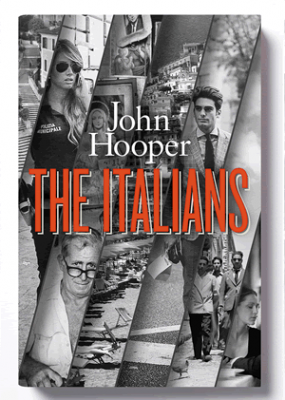Books: Italy's muddle of contradictions

John Hooper’s The Italians is an introduction to contemporary Italy, aiming to reveal ‘what makes Italians tick.’
With more than 30 years’ experience as a foreign correspondent and a similar study, The Spaniards (later revised), to his name, Hooper handles Italy’s muddle of contradictions to produce a fine read.
Hooper interweaves themes and arguments, and considers pre-conceptions.‘Fidarsi è bene non fidarsi è meglio: “To trust is good; not to trust is better” reads the proverb that introduces Chapter 13. Society rewards furbizia (cunning) above fesseria(stupidity), and for stupidity, read honesty.
Paying your taxes is for naïve fessi(idiots). Anxiety to fare una bella figura: to make a good impression shackles expression and change. Hooper illustrates with tales of exaggerated gift-wrapping, the strict etiquette of greetings and a Corriere della Sera feature contrasting the fashions of British politicians and wives. Symbols and gestures reveal underlying truths. However, lack of vigour in Italian journalism means there is never objective verità.
Jostling for power and status lies in the everyday farce of Italian titles, exchanges and loyalties. Everyone’s a dottore, professore or presidente it seems. So Hooper plays with the local barista who is keen to pin down his profession and expects exclusive custom. We learn about the dual number mobile Sim card, Alter Ego, tailored to duplicity and extra-marital affairs.
Opening chapters explain that Italy’s rugged geography separated communities and made it vulnerable to foreign invasion. Fragmentation, conflict and diversity leave positive and negative legacies. Diversity enabled competitive central and northern states to create the Renaissance; unification steered by Piedmontese and Papal interests; the birth and entrenchment of the mafia; and Fascist lottizazione: the dispersal of power in a corporate state.
History has bred national insecurity: an innate distrust, conservativism and loathing of war. Humiliated Italy became a pawn in European politics. Fresh scars inflicted by Cold War politics laid the ground for Berlusconi’s ‘national capitalism’. A vincolo esterno, or external foreign influence looms large.
The family and Catholicism are mainstays of Italian life, breeding ‘amoral familism’ above civismo (civic-pride). Hooper describes pervasive corruption and exchanging favours: half of all Italians owe their jobs to raccomandazioni. Fiefdoms and restrictive practices dominate professions, stifling innovation and foreign investment.
Then there’s the Italian mother and son relationship, and the effects of the mammismo (mother’s boy) and maschilismo on wider society and gender stereotyping. The phenomenon of bamboccioni – stay at home young adults – reinforces the gerontocracy. Nostalgia for Totò and Sordi fill newsstands, while youth movements are limp. Fascism halted feminism and ricatto sessuale (sexual extortion) is so entrenched that when Berlusconi’s bunga bunga tales broke people demanded ‘If not now, when?’ The ex-Pm frequently reanimates the book, from his copiatura (cheating at school) to media stranglehold, or ‘videocracy’.
Latter chapters unravel the ineffective and ‘cruel judiciary’; explain the spread of the mafia; and tackle football obsession. The author’s Iberian and Japanese experiences offer novel comparisons. He likens Italy to Japan – both share seismic and geographical similarities and some cultural: in both countries appearances are valued highly and cartel-like structures (including organized crime) are rife.
The Italians acts as a handy glossary to Italian life and idiom. We learn about lettori taking on baroni (foreign lecturers fighting protectionist professors for basic employment rights); menefreghismo (not caring), vallette and veline (TV show girls); and dietrologia (divining motives).
In the chiaroscuro Italian way of life, Hooper also celebrates sunnier aspects: their generosity, readiness to forgive and pride in the art of living well: “In central Italy, there are those who, one feels, would rather lose a month’s wages than admit that bucatini all’amitriciana can be made with anything other than pork jowl.” Hooper spots green shoots of youthful change among the skein of stubborn roots that stifles progress. Perhaps the youth frustrated with Italy’s malaise who increasingly seek opportunities abroad will stir things up on their return. Hooper notes that both family and church traditions are being eroded and Italy will have to adapt.
Italian fantasia may have spawned the megalomania and illusionism of Mussolini and Berlusconi. But these are counterbalanced by aesthetic and cultural achievements – from Renaissance art treasures and modern design, to blurring of fact and fiction in Fellini’s films and Pirandello’s theatre. Indeed, the uncertainty and illusory facts presented in Pirandello’s absurdist plays, says Hooper are "very much like the experience of living in Italy.” The trick is in deciphering the meaning.
Nick Bruno grew up in London, and studied History and Italian at Manchester and Venice Universities. He came to journalism in his early 30s after leading jinxed tours across Europe, peddling outdoor kit and translating Italian into English. He writes about travel and culture mainly and has authored a number of travel books about Italy.
The Italians, By John Hooper, Allen Lane, 318pp, RRP £20



